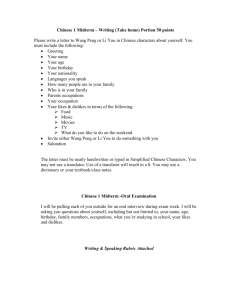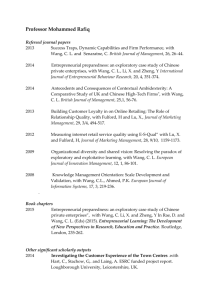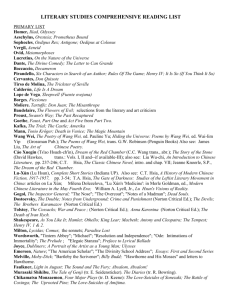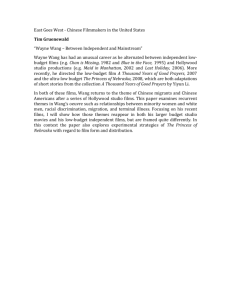Outline of Chapter 6
advertisement
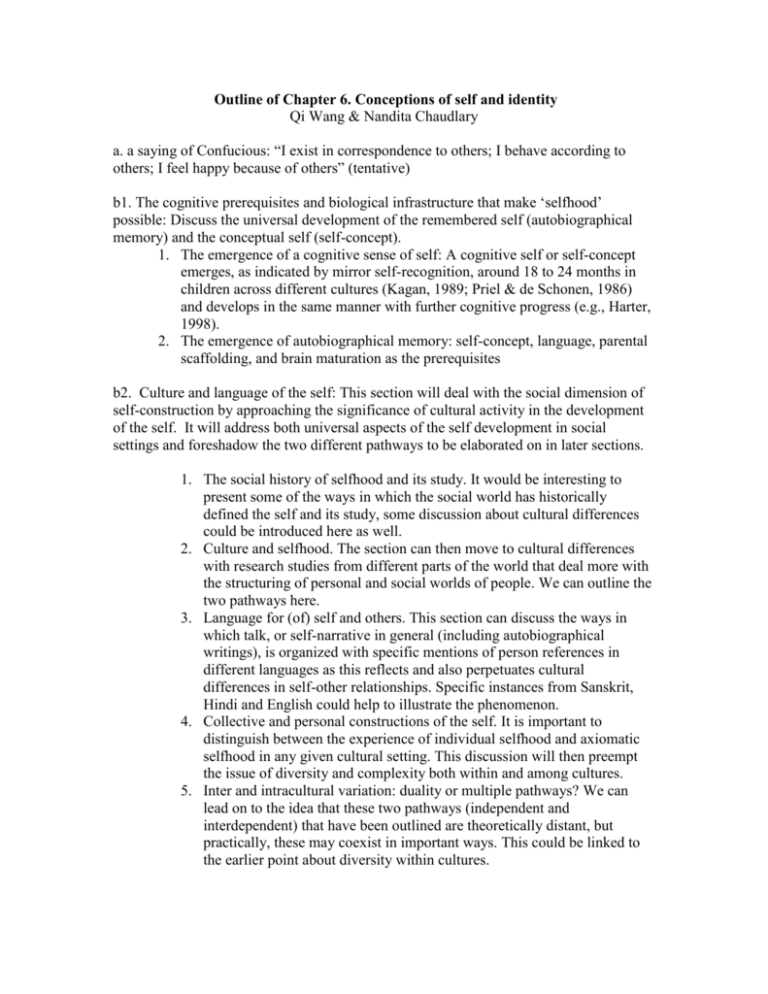
Outline of Chapter 6. Conceptions of self and identity Qi Wang & Nandita Chaudlary a. a saying of Confucious: “I exist in correspondence to others; I behave according to others; I feel happy because of others” (tentative) b1. The cognitive prerequisites and biological infrastructure that make ‘selfhood’ possible: Discuss the universal development of the remembered self (autobiographical memory) and the conceptual self (self-concept). 1. The emergence of a cognitive sense of self: A cognitive self or self-concept emerges, as indicated by mirror self-recognition, around 18 to 24 months in children across different cultures (Kagan, 1989; Priel & de Schonen, 1986) and develops in the same manner with further cognitive progress (e.g., Harter, 1998). 2. The emergence of autobiographical memory: self-concept, language, parental scaffolding, and brain maturation as the prerequisites b2. Culture and language of the self: This section will deal with the social dimension of self-construction by approaching the significance of cultural activity in the development of the self. It will address both universal aspects of the self development in social settings and foreshadow the two different pathways to be elaborated on in later sections. 1. The social history of selfhood and its study. It would be interesting to present some of the ways in which the social world has historically defined the self and its study, some discussion about cultural differences could be introduced here as well. 2. Culture and selfhood. The section can then move to cultural differences with research studies from different parts of the world that deal more with the structuring of personal and social worlds of people. We can outline the two pathways here. 3. Language for (of) self and others. This section can discuss the ways in which talk, or self-narrative in general (including autobiographical writings), is organized with specific mentions of person references in different languages as this reflects and also perpetuates cultural differences in self-other relationships. Specific instances from Sanskrit, Hindi and English could help to illustrate the phenomenon. 4. Collective and personal constructions of the self. It is important to distinguish between the experience of individual selfhood and axiomatic selfhood in any given cultural setting. This discussion will then preempt the issue of diversity and complexity both within and among cultures. 5. Inter and intracultural variation: duality or multiple pathways? We can lead on to the idea that these two pathways (independent and interdependent) that have been outlined are theoretically distant, but practically, these may coexist in important ways. This could be linked to the earlier point about diversity within cultures. 6. The multifaceted nature of the self. We will conceive of the self as a multi-layered, multi-dimensional, and complex, dynamic system (as opposed to a totality). The different facets can sometimes be contradictory to each other in their orientations toward autonomy vs. relatedness. This complex self-construct may further contribute to the inter and intracultural variations (We can present relevant examples in the discussion of each pathway). c. The individualistic pathway 1. A discussion of the cultural origins of the autonomous self (Mead, 2002; Roland, 1988). 2. Institutional: normative goals in, e.g., schools (Tobin et al., 1988; Stigler & Perry, 1990). 3. Psychological: parental ethnotheories (Ruth Chao) 4. socialization practices pertinent to facilitating the development of an autonomous self: within-culture variations (e.g., Wiley et al., 1998) and between-culture variations (e.g., Dunn, & Brown,1991 "British-US"). 5. behavioral development: autobiographical memory and self in children, young adults, and older adults (Wang et al.) 6. "the autonomous self" in societies that generally deemphasize individuality (de Bary, 1970; Li): This section examines the different dimensions of the self that show either an autonomous or a relational orientation within a single individual and within a single culture. For example, the "achievement" dimension of the Chinese self is oriented towards autonomy, even though Chinese culture promotes interdependence in general. This will echo our discussion on the multifaceted nature of the self. d. The interdependent pathway 1. A discussion of the cultural origins of the relational self 2. Institutional: normative goals in, e.g., schools (Tobin et al., 1988; Stigler & Perry, 1990). 3. Psychological: parental ethnotheories (Ruth Chao) 4. socialization practices pertinent to facilitating the development of a relational self: within-culture variations (e.g., Wang et al., 1998) and between-culture variations (e.g., Han et al.,1998 "Korea-China"). 5. behavioral development: autobiographical memory and self in children, young adults, and older adults (Wang et al.) 6. "the relation self" in societies that generally deemphasize relatedness (e.g., gender) I WONDER IF FEMALE EMPHASIS ON RELATIONSHIPS SHOULD BE CONSIDERED PART OF THE RELATIONAL SELF IN SOCIETIES THAT GENERALLY DEEMPHASIZE RELATED NESS OR SHOULD BE CONSIDERED A CULTURALLY STRUCTURED PART OF THE INDIVIDUATED SELF - EX: JOAN MILLER POINTING OUT THAT THE GILLIGAN RELATIONAL ORIENTATION IS BY CHOICE RATHER THAN SOCIAL OBLIGATION, MAKING IT PART OF AN INDEPENDENT/INDIVIDUALISTIC MORALITY, RATHER THAN PART OF A MORALITY OF SOCIAL OBLIGATION/RESPONSIBILITY. PMG e. Effects of social change and interactions between the pathways on socialization and development Three examples: 1. Chinese only children (Wang et al., 1998) 2. Asian-Americans parents emphasize both autonomy and relatedness 3. The multiple and sometimes contradictory expectations of urban Indian parents, where, for instance, a young person may be expected to be competitive at the work-place and cooperative at home. This will be related to our earlier discussion on the multifaceted nature of the self. THIS IS GREAT! f. Policy and practice: Implications of the two self pathways for parenting, education, acculturation and adaptation of immigrants, intercultural exchange, etc. g. Summary with bullet points h. Photographs or other illustrations that would illustrate research and theory i. Some figures and tables j. About 9000 words per chapter Selected References Chao, R. K. (1995). Chinese and European American cultural models of the self reflected in mothers’ childrearing beliefs. Ethos, 23, 3, 328-354. Conway, M., & Pleydell-Pearce, C. W. (2000). The construction of autobiographical memories in the self-memory system. Psychological Review, 107, 2, 261-288. de Bary, W. T. (1970). Individualism and humanitarianism in late Ming thought. In W. T. de Bary (Ed.), Self and society in Ming thought (pp. 145-247). New York: Columbia University Press. Dunn, J. & Brown, J. (1991). Becoming American or English? Talking about the social world in England and the United States. In M. H. Bornstein (Ed.), Cross-cultural approaches to parenting (pp. 155-172). Hilllsdale, NJ: Laurence Erlbaum Associates. Fivush, R. (1994). Constructing narrative, emotions, and self in parent-child conversations about the past. In U. Neisser & R. Fivush (Eds), The remembering self: construction and accuracy in the self-narrative (pp. 136-157). New York: Cambridge University Press. Greenfield, P. (1997). Culture as process: Empirical methodology for cultural psychology. In J. W. Berry, Y. H. Poortinga, & J. Pandey (Eds.), Handbook of cross-cultural psychology: Vol. 1, Theory and method (pp. 301-346). Boston: Allyn & Bacon. Han, J. J., Leichtman, M. D., & Wang, Q. (1998). Autobiographical memory in Korean, Chinese, and American children. Developmental Psychology, 34, 4, 701-713. Harter, S. (1998). The development of self-representations. In W. Damon (Ed.), Handbook of child psychology, vol. (5th ed.) (pp. 553-617). New York: Wiley. Harter, S. (1999). The construction of the self : A developmental perspective. New York: Guilford Press. Hart, D., & Edelstein, W. (1992). Self-understanding development in cross-cultural perspective. In T. M. Brinthaupt & R. P. Lipka (Eds.), The self: Definitional and methodological issues (pp. 291-322). NY: State University of New York Press. Hart, D., Lucca-Irizarry, N., & Damon, W. (1986). The development of selfunderstanding in Puerto Rico and the United States. Journal of Early Adolescence, 6, 293-304. Hsu, F. L. K. (1970). Americans and Chinese: Purpose and fulfillment in great civilizations. New York: The Natural History Press. Howe, M. L. & Courage, M. L. (1997). The emergence and early development of autobiographical memory. Psychological Review, 104, 3, 499-523. Kagan, J. (1989). Unstable ideas: Temperament, cognition, and self. Cambridge, MA: Harvard University Press. Kagitcibasi, C. (1996). Family and Human Development across Cultures: A View from the Other Side. Hillsdale, NJ: Erlbaum. Markus, H.R. & Kitayama, S. (1991). Culture and the self: Implications for cognition, emotion, and motivation. Psychological Review, 98, 2, 224-253. Miller, P. J., Fung, H., & Mintz, J. (1996). Self-construction through narrative practices: A Chinese and American comparison of early socialization. Ethos, 24, 2, 237-280. Mullen, M. K. (1994). Earliest recollections of childhood: A demographic analysis. Cognition, 52, 1, 55-79. Shweder, R. A., Goodnow, J., Hatano, G., LeVine, R. A., Markus, H., & Miller, P. (1998). The cultural psychology of development: One mind, many mentalities. In W. Damon (Series Ed.), and R. M. Lerner (Vol. Ed.), Handbook of child psychology (5th Ed.), Vol. 1. Theoretical models of human development (pp. 865-937). New York: Wiley & Sons. Shweder, R. A., & Miller, G. (1991). The social construction of the person. In R. A. Shweder (Ed.), Thinking through cultures (pp. 156-185). Cambridge, MA: Harvard University Press. Shweder, R. A., & Bourne, E. J. (1984). Does the concept of the person very crossculturally? In R. A. Shweder & R. A. LeVine (Eds.), Culture theory: Essays on mind, self, and emotion (pp. 158-199). New York: Cambridge University Press. Stigler, J. W. & Perry, M. (1990). Mathematics learning in Japanese, Chinese, and American classrooms. In J. W. Stigler, R. A. Shweder, & G. Herdt (Eds.), Cultural psychology (pp. 328-353), NY: Cambridge University Press. Stigler, J. W., Smith, S., & Mao, L. W. (1985). The self-perception of competence by Chinese children. Child Development, 56, 1259-1270. Triandis, H.C. (1989). The self and social behavior in differing cultural contexts. Psychological Review, 96, 506-520. Wang, Q. (2001). Cultural effects on adults' earliest childhood recollection and selfdescription: Implications for the relation between memory and the self. Journal of Personality and Social Psychology, 81, 2, 220-233. Wang, Q. (2003). Infantile amnesia reconsidered: A cross-cultural analysis. Memory, 11, 1, 65-80. Wang, Q. & Conway, M. A. (submitted). The stories we keep: Autobiographical memory in American and Chinese middle-aged adults. Wang, Q., Leichtman, M. D., & Davies, K. (2000). Sharing memories and telling stories: American and Chinese mothers and their 3-year-olds. Memory, 8, 3, 159-177. Wang, Q., Leichtman, M. D., & White, S. H. (1998). Childhood memory and selfdescription in young Chinese adults: The impact of growing up an only child. Cognition, 69, 1, 75-105. Wiley, A. R., Rose, A. J., Burger, L. K., & Miller, P. J. (1998). Constructing autonomous selves through narrative practices: A comparative study of working-class and middle-class families. Child-Development, 69, 3, 833-847.
